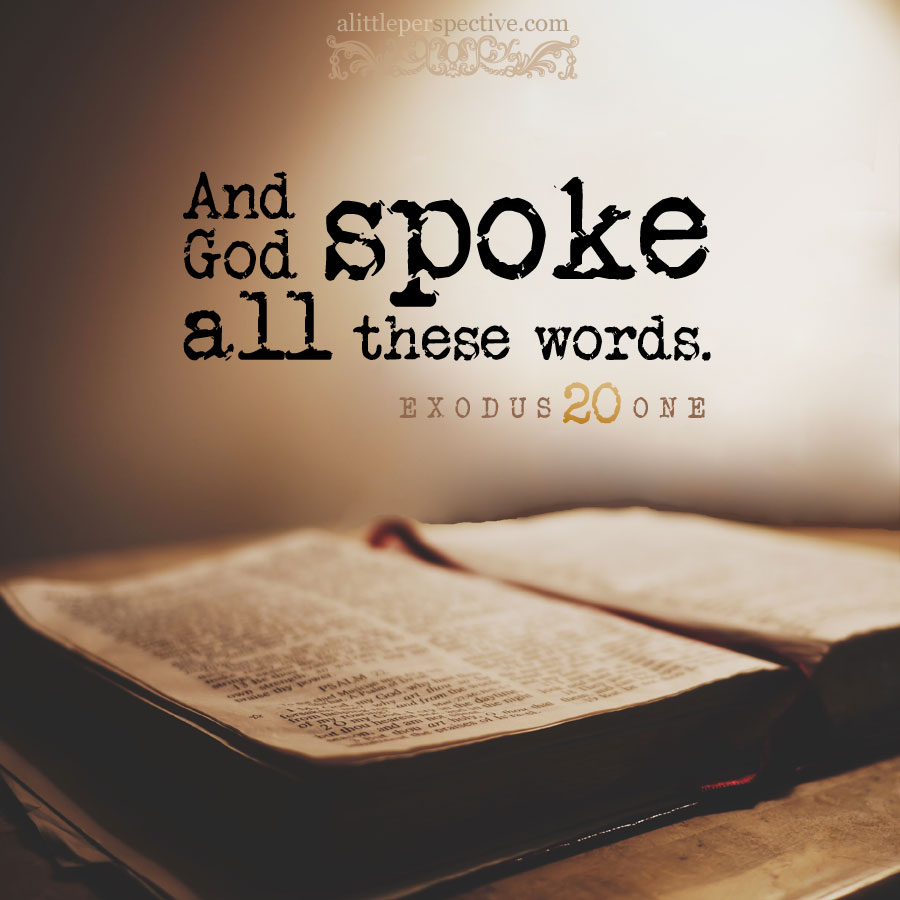 Background photo by Aaron Burden on Unsplash.
Background photo by Aaron Burden on Unsplash.
Read Exodus 20:1 at Bible Gateway.
Hebrew paragraph division
Exo 20:1 {s} And God spoke all these words, saying,
Hebrew roots
God is Strong’s H430, Elohiym.
To speak is Strong’s H1696 דבר dabar, a primitive root meaning, “to speak.” The ancient pictographs are dalet + bet + resh.
dalet ד = the door, thus enter, move, hang
bet ב = the house, thus house, household, family, in, within
resh ר = the head of man, thus head, first, top, beginning, man
The story the ancient pictographs are telling is of the back and forth movement (dalet, as a door swings back and forth when entering and exiting) within the household (bet) of a man (resh). In ancient days among the Semitic nomads, life followed an orderly arrangement of movement throughout the year, following the seasons in pasturing their flocks. This movement was repeated year and after year, thus the back and forth movement like the curtain in a doorway which moves back and forth as one enters and exits. However, a very specific order of movement was followed, thus the verb came to be widely used to mean “setting in order,” or “speaking,” as a verbal address follows from setting one’s words in order.
Word is Strong’s H1697, dabar, a concrete noun meaning, “word;” from Strong’s H1696 דבר dabar, the primitive root meaning, “to speak,” above.
To say is Strong’s H559 אמר amar, a primitive root meaning, “to say.” The ancient pictographs are aleph + mem + resh.
aleph א = the ox head, thus strength, power, leader
mem מ, ם = the water, thus chaos, mighty, blood
resh ר = the head of man, thus head, first, top, beginning, man
The story being told seems to be power (aleph) over chaos (mem) in the beginning (resh). The root appears to be referring to its first use in Scripture:
In the beginning God created the heaven and the earth. Now the earth was unformed and void, and darkness was on the face of the deep. And the Spirit of God hovered over the face of the waters. And God said, “Let there be light;” and there was light. Gen 1:1-3
God exerted power over chaos in the beginning, when He said – amar, its first use in Scripture – “Let there be light.”
What is the difference between to “to speak,” dabar, and “to say,” amar? Dabar seems to mean arranging ordinary words in order; while amar seems to mean, the spoken Word of God, that Word which contains the intrinsic power within itself to create and uphold the universe (I have not gone through every use of dabar and amar in Scripture to verify this theory yet).
God, who at various times and in various ways spoke in time past to the fathers by the prophets, has in these last days spoken to us by His Son, whom He has appointed heir of all things, through whom also He made the worlds; who being the brightness of His glory and the express image of His person, and upholding all things by the word of His power, when He had by Himself purged our sins, sat down at the right hand of the Majesty on high … Heb 1:1-3
Exo 20:1 chiastic structure
Now why would God put this sentence fragment in its own paragraph? The central axis emphasizes that all the words which follow, which are the Ten Words of the Ten Commandments, are the words which God spoke; i.e., He is their author, therefore they carry the weight of His authority as Creator and King and now, Husband of Israel. They did not come from the mind of Moses.
All, according to Webster’s, means, “the whole amount, quantity, or extent of; every member or individual component of.” Every one of the Ten is thus saith the LORD, including that one (whichever it is) which is being relegated to the trash heap by the culture of the day.

















Leave a Reply